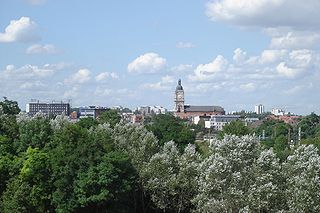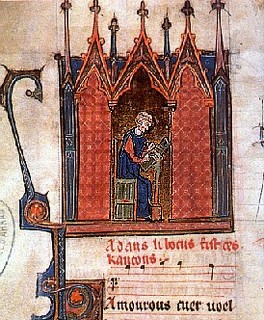Adam de Givenchi (fl. 1230–1268) was a trouvère, probably from Givenchy and active in and around Arras. His surname is also spelled Givenci, Gevanche, or Gievenci.
Floruit, abbreviated fl., Latin for "he/she flourished", denotes a date or period during which a person was known to have been alive or active. In English, the word may also be used as a noun indicating the time when someone "flourished".
Trouvère, sometimes spelled trouveur[tʁuvœʁ], is the Northern French form of the langue d'oc (Occitan) word trobador. It refers to poet-composers who were roughly contemporary with and influenced by the troubadours but who composed their works in the northern dialects of France. The first known trouvère was Chrétien de Troyes and the trouvères continued to flourish until about 1300. Some 2130 trouvère poems have survived; of these, at least two-thirds have melodies.
Givenchy is a French luxury fashion and perfume house. It hosts the brand of haute couture clothing, accessories and Parfums Givenchy, perfumes and cosmetics. The house of Givenchy was founded in 1952 by designer Hubert de Givenchy and is a member of Chambre Syndicale de la Haute Couture et du Pret-a-Porter. It is owned by luxury conglomerate LVMH. Its current artistic director is Clare Waight Keller, who is the first woman to hold that position.
Contents
Adam appears in charters of May and July 1230 as a clerk of the Bishop of Arras. He was still serving in the household of the bishop in 1232. In 1243 he was named as a priest and chaplain to the bishop. [1] In 1245 he was the doyen of Lens.

A priest is a religious leader authorized to perform the sacred rituals of a religion, especially as a mediatory agent between humans and one or more deities. They also have the authority or power to administer religious rites; in particular, rites of sacrifice to, and propitiation of, a deity or deities. Their office or position is the priesthood, a term which also may apply to such persons collectively.

A chaplain is, traditionally, a cleric, or a lay representative of a religious tradition, attached to a secular institution such as a hospital, prison, military unit, school, labor union, business, police department, fire department, university, or private chapel.

Lens is a commune in the Pas-de-Calais department in northern France. It is one of the main towns of Hauts-de-France along with Lille, Valenciennes, Amiens, Roubaix, Tourcoing, Arras and Douai. The inhabitants are called Lensois.
In Arras he associated with the poets Simon d’Authie, Pierre de Corbie, Guillaume Le Vinier, [2] and Jehan Bretel. He wrote one jeu parti with each of the last two, and the composition with Guillaume (Amis Guillaume, ainc si sage ne vi) has several surviving melodies. Six other poems survive to his name, four with melodies. Two of these are chansons avec des refrains . All the songs are in AAB form and the melodies are simple.
Pierre de Corbie was an early trouvère from the Île-de-France. He is probably the same person as the magister Petrus de Corbeia who served as a canon at Notre Dame d'Arras between 1188 and 1195. All seven of his surviving songs are found in only a few sources; all the melodies are in bar form and several songs have been assigned different melodies by different sources:
Jehan Bretel (c.1210–1272) was a trouvère. Of his known oeuvre of probably 97 songs, 96 have survived. Judging by his contacts with other trouvères he was famous and popular. Seven works by other trouvères are dedicated to Bretel and he was for a time the "Prince" of the Puy d'Arras.
